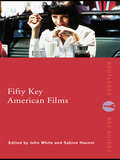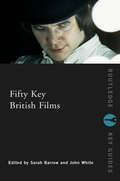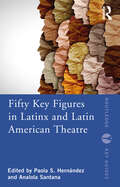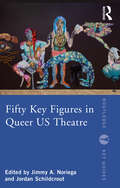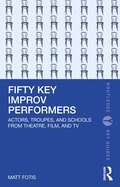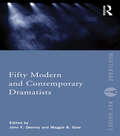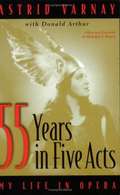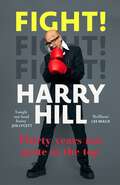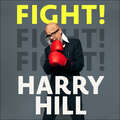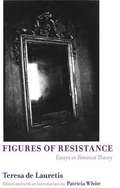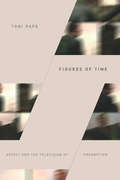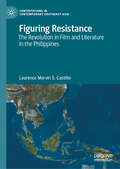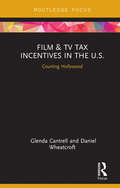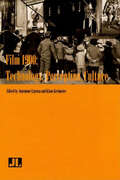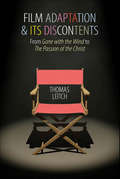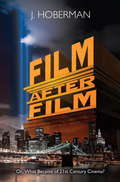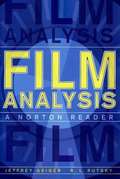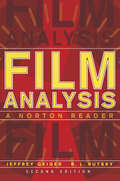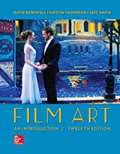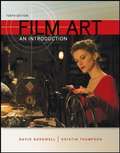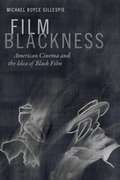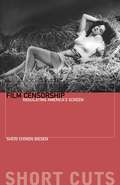- Table View
- List View
Fifty Key American Films (Routledge Key Guides)
by John White Sabine HaenniFifty Key American Films explores and contextualises some of the most important films ever made in the United States. With case studies from the early years of cinema to the present day, this comprehensive Key Guide provides accessible analyses from a range of theoretical perspectives. This chronologically ordered volume includes coverage of: Citizen Kane Casablanca Psycho Taxi Driver Blade Runner Pulp Fiction Amongst a raft of well-known films, the work of some of America’s best known directors, such as Lynch, Scorsese, Coppola and Scott, is discussed. This book is essential reading for students of film, and will be of interest to anyone seeking to explore the impact of American cinema.
Fifty Key British Films (Routledge Key Guides)
by John White Sarah BarrowIn Fifty Key British Films, Britain's best known films such as Clockwork Orange, The Full Monty and Goldfinger are scrutinised for their outstanding ability to articulate the issues of the time. This is essential reading for anyone interested in quality, cult film.
Fifty Key Figures in LatinX and Latin American Theatre (Routledge Key Guides)
by Paola S HernándezFifty Key Figures in Latinx and Latin American Theatre is a critical introduction to the most influential and innovative theatre practitioners in the Americas, all of whom have been pioneers in changing the field. The chosen artists work through political, racial, gender, class, and geographical divides to expand our understanding of Latin American and Latinx theatre while at the same time offering a space to discuss contested nationalities and histories. Each entry considers the artist’s or collective’s body of work in its historical, cultural, and political context and provides a brief biography and suggestions for further reading. The volume covers artists from the present day to the 1960s—the emergence of a modern theatre that was concerned with Latinx and Latin American themes distancing themselves from an European approach. A deep and enriching resource for the classroom and individual study, this is the first book that any student of Latinx and Latin American theatre should read.
Fifty Key Figures in Queer US Theatre (Routledge Key Guides)
by Jordan Schildcrout Jimmy A. NoriegaWhether creating Broadway musicals, experimental dramas, or outrageous comedies, the performers, directors, playwrights, designers, and producers profiled in this collection have contributed to the representation of LGBTQ lives and culture in a variety of theatrical venues, both within the queer community and across the US theatrical landscape. Moving from the era of the Stonewall Riots to today, notable scholars in the field bring a wide variety of queer theatre artists into conversation with each other, exploring connections and differences in race, gender, physical ability, national origin, class, generation, aesthetic modes, and political goals, creating a diverse and inclusive study of 50 years of queer theatre. For readers seeking an introduction to or a deeper understanding of LGBTQ theatre, this volume offers thought-provoking analyses of theatre-makers both celebrated and lesser-known, mainstream and subversive, canonical and new.
Fifty Key Improv Performers: Actors, Troupes, and Schools from Theatre, Film, and TV (Routledge Key Guides)
by Matt FotisFifty Key Improv Performers highlights the history, development, and impact of improvisational theatre by highlighting not just key performers, but institutions, training centers, and movements to demonstrate the ways improv has shaped contemporary performance both onstage and onscreen. The book features the luminaries of improv, like Viola Spolin, Keith Johnstone, and Mick Napier, while also featuring many of the less well‑known figures in improvisation who have fundamentally changed the way we make and view comedy – people like Susan Messing, Jonathan Pitts, Robert Gravel, and Yvon Leduc. Due to improv’s highly collaborative nature, the book features many of the art form’s most important theatres and groups, such as The Second City, TJ & Dave, and Oui Be Negroes. While the book focuses on the development of improvisation in the United States, it features several entries about the development of improv around the globe. Students of Improvisational Theatre, History of Comedy, and Performance Studies, as well as practitioners of comedy, will benefit from the wide expanse of performers, groups, and institutions throughout the book.
Fifty Modern and Contemporary Dramatists (Routledge Key Guides)
by Maggie B. Gale John F. DeeneyFifty Modern and Contemporary and Dramatists is a critical introduction to the work of some of the most important and influential playwrights from the 1950s to the present day. The figures chosen are among the most widely studied by students of drama, theatre and literature and include such celebrated writers as: • Samuel Beckett • Caryl Churchill • Anna Deavere Smith • Jean Genet • Sarah Kane • Heiner Müller • Arthur Miller • Harold Pinter • Sam Shephard Each short essay is written by one of an international team of academic experts and offers a detailed analysis of the playwright’s key works and career. The introduction provides an historical and theatrical context to the volume, which provides an invaluable overview of modern and contemporary drama.
Fifty Years of "The Battle of Algiers": Past as Prologue (Forerunners: Ideas First)
by Sohail DaulatzaiThe Battle of Algiers, a 1966 film that poetically captures Algerian resistance to French colonial occupation, is widely considered one of the greatest political films of all time. With an artistic defiance that matched the boldness of the anticolonial struggles of the time, it was embraced across the political spectrum—from leftist groups like the Black Panther Party and the Palestine Liberation Organization to right-wing juntas in the 1970s and later, the Pentagon in 2003. With a philosophical nod to Frantz Fanon, Sohail Daulatzai demonstrates that tracing the film&’s afterlife reveals a larger story about how dreams of freedom were shared and crushed in the fifty years since its release. As the War on Terror expands and the &“threat&” of the Muslim looms, The Battle of Algiers is more than an artifact of the past—it&’s a prophetic testament to the present and a cautionary tale of an imperial future, as perpetual war has been declared on permanent unrest.Forerunners: Ideas First is a thought-in-process series of breakthrough digital publications. Written between fresh ideas and finished books, Forerunners draws on scholarly work initiated in notable blogs, social media, conference plenaries, journal articles, and the synergy of academic exchange. This is gray literature publishing: where intense thinking, change, and speculation take place in scholarship.
Fifty-five Years in Five Acts: My Life in Opera
by Astrid Varnay Donald ArthurFor Astrid Varnay, opera was the family business. The daughter of coloratura soprano Mária Jávor and dramatic tenor Alexander Várnay, she literally grew up backstage at the opera. Vocally and musically trained by her mother and mentor (and later husband) Hermann Weigert, she was just twenty-three years old when she made her unofficial debut at the Metropolitan Opera as a last-minute replacement for the suddenly ill Lotte Lehmann. Varnay's critically acclaimed performance as Sieglinde in Die Walküre catapulted her into the limelight. Varnay reflects on her remarkable life in opera, discussing her signature roles and performances, vocal preparation and technique, interpretive acting style, and her seamless transition from leading soprano to character roles, including her switch from Elektra to Klytemnästra in Strauss's Elektra. Her engaging and witty memoir is filled with frank, often critical, observations about many of the most significant vocal artists, conductors, and directors of the twentieth century. She describes her lifelong friendship with operatic idol Kirsten Flagstad, the years at the Met and conflicts with Rudolf Bing, her appearances at the Bayreuth and Salzburg Festivals, and her artistic rift with Herbert von Karajan.<P><P> This book is also listed in libraries as "55 Years in Five Acts: My Life in Opera"
Fight!: Thirty Years Not Quite at the Top
by Harry Hill'The funniest man in the world has written the funniest book in the world.' DAVID WALLIAMS'A brilliant insight in to what it takes to go from regular funny bloke to one of the best stand ups I've ever seen.' LEE MACK'Proper laugh-out-loud funny, fascinating, and doubles up as probably the best book of advice on how to be a comedian I've ever read. A must for anyone who's interested in the business of laughter.' JOE LYCETTFrom a childhood spent making smoke bombs, killing wasps and carving soap in 70s Kent, Harry Hill then found himself in charge of hundreds of sick people as a junior doctor. Out of his depth and terrified, he chucked it all in to pursue his dream of becoming a stand-up comedian. Battling his way through the 90s Comedy circuit he quickly rose to become a household name and one of the UK's most celebrated comics, almost making it to the top of the showbiz tree . . .From being chased around a car park by an angry heckler, getting fired from Capital Radio and watching every episode of Freaky Eaters, to a bizarre assassination attempt and cutting up Simon Cowell's trousers, Harry takes an honest and hilarious look at the ups and downs of his life and career through the lens of what didn't go right.He shares his secrets on how to be a great comedian, finding joy in failure and creativity in struggle, whilst never forgetting that life is short . . .
Fight!: Thirty Years Not Quite at the Top
by Harry Hill'The funniest man in the world has written the funniest book in the world.' DAVID WALLIAMS'A brilliant insight in to what it takes to go from regular funny bloke to one of the best stand ups I've ever seen.' LEE MACK'Proper laugh-out-loud funny, fascinating, and doubles up as probably the best book of advice on how to be a comedian. A must for anyone who's interested in the business of laughter.' JOE LYCETTFrom a childhood spent making smoke bombs, killing wasps and carving soap in 70s Kent, Harry Hill then found himself in charge of hundreds of sick people as a junior doctor. Out of his depth and terrified, he chucked it all in to pursue his dream of becoming a stand-up comedian. Battling his way through the 90s Comedy circuit he quickly rose to become a household name and one of the UK's most celebrated comics, almost making it to the top of the showbiz tree . . .From being chased around a car park by an angry heckler, getting fired from Capital Radio and watching every episode of Freaky Eaters, to a bizarre assassination attempt and cutting up Simon Cowell's trousers, Harry takes an honest and hilarious look at the ups and downs of his life and career through the lens of what didn't go right.He shares his secrets on how to be a great comedian, finding joy in failure and creativity in struggle, whilst never forgetting that life is short . . .What readers are saying about Fight!'Hilarious... recommended unreservedly' *****'Lots of laughs and memories of days gone by' *****'A great book... I could not put it down' *****'Beautifully written and great fun' *****(P) 2021 Hodder & Stoughton Limited
Fight!: Thirty Years Not Quite at the Top
by Harry HillA TIMES BEST COMEDY BOOK OF 2021'The funniest man in the world has written the funniest book in the world' DAVID WALLIAMS'A brilliant insight into what it takes to go from regular funny bloke to one of the best stand-ups I've ever seen' LEE MACK'Proper laugh-out-loud funny, fascinating, and...a must for anyone who's interested in the business of laughter' JOE LYCETTAfter a childhood spent making smoke bombs, killing wasps and carving soap in 70s Kent, Harry Hill then found himself in charge of hundreds of sick people as a junior doctor. Out of his depth and terrified, he chucked it all in to pursue his dream of becoming a stand-up comedian. Battling his way through the 90s comedy circuit he quickly rose to become a household name and one of the UK's most celebrated comics, almost making it to the top of the showbiz tree...From being chased by an angry heckler and getting fired from Capital Radio to a bizarre assassination attempt and cutting up Simon Cowell's trousers, Harry takes an honest and hilarious look at the ups and downs of his life and career, finding joy in failure and creativity in struggle, whilst never forgetting that life is short.
Fighting for Air: In the Trenches with Television News
by Liz TrottaLiz Trotta traces her career from the early days of broadcast news to the slick superficiality of today. The first female television correspondent in Vietnam, Trotta tells the searing truth about being a woman in a male-dominated industry and recounts many of her most fascinating stories, from the scandal of Chappaquiddick to the campaign trail of George Bush.
Figures of Resistance: Essays in Feminist Theory
by Patricia White Teresa De LauretisThe changing face of feminist discourse as reflected by the career of one of its preeminent scholars Figures of Resistance brings together the unpublished lectures and little-seen essays of internationally renowned theorist Teresa de Lauretis, spanning over twenty years of her finest work. Thirty years after the height of feminist theory, this collection invites us to reflect on the history of feminism and take a hard look at where it stands today. Selected essays include "Sexual Indifference and Lesbian Representation," "The Lure of the Mannish Lesbian," "Eccentric Subjects," "Habit Changes," "The Intractability of Desire," and the unpublished article "Figures of Resistance." An introduction from feminist film scholar Patricia White provides an overview of the development of de Lauretis's thought and of feminist theory over past decades.
Figures of Time: Affect and the Television of Preemption (Thought in the Act)
by Toni PapeMany contemporary television series from Modern Family to How to Get Away with Murder open an episode or season with a conflict and then go back in time to show how that conflict came to be. In Figures of Time Toni Pape examines these narratives, showing how these leaps in time create aesthetic experiences of time that attune their audiences to the political doctrine of preemption—a logic that justifies preemptive action to nullify a perceived future threat. Examining questions of temporality in Life on Mars, the political ramifications of living under the auspices of a catastrophic future in FlashForward, and how Damages disrupts the logic of preemption, Pape shows how television helps shift political culture away from a model of rational deliberation and representation toward a politics of preemption and conformity. Exposing the mechanisms through which television supports a fear-based politics, Pape contends, will allow for the rechanneling of television's affective force into building a more productive and positive politics.
Figuring Resistance: The Revolution in Film and Literature in the Philippines (Contestations in Contemporary Southeast Asia)
by Laurence Marvin CastilloThis book examines how fiction films and novels represent the communist-led national democratic (NatDem) revolution in the Philippines. Produced aboveground decades after the Philippines’ historic transition from dictatorship to elite democracy, these NatDem fictions depict how the communist movement in the Philippines confronted various national and global changes, tracking revolutionary experiences amidst the ascendancy of neoliberalism, the continuation of counterinsurgency and the emergence of non-Marxist social movements and discourses. Figuring Resistance studies how fictions portray the tenacity of political commitment among revolutionaries engaged in the revolution's manifold history of crises, setbacks, and persistence. It illuminates the crucial role played by cultural work in creating and nourishing an oppositional public sphere, where the experiential makings of the liberation struggle in the Third World can be imagined.
Film & TV Tax Incentives in the U.S.: Courting Hollywood (Routledge Studies in Media Theory and Practice)
by Glenda Cantrell Daniel WheatcroftEntertainment tax incentives are one of the greatest tools in the arsenal of filmmaking. They pay a portion of production expenditures back to the filmmaker, while creating powerful economic engines for the states who implement them properly. They are high in the list of considerations for executives to sign off before a movie receives the go-ahead for production, even to the point of dictating the location of where a production is filmed. Yet, they are misunderstood by the filmmakers who use them, the politicians who create them, the economists who measure them, and even the scholars who study them. This book puts all the pieces together in a comprehensive look at how the entertainment industry works, how it uses incentives, and how incentives can benefit a filmmaker – or a state.
Film 1900: Technology, Perception, Culture
by Klaus Kreimeier Annemone LigensaThe current digital revolution has sparked a renewed interest in the origins and trajectory of modern media, particularly in the years around 1900 when the technology was rapidly developing. This collection aims to broaden our understanding of early cinema as a significant innovation in media history. Joining traditional scholarship with fresh insights from a variety of disciplines, this book explains the aesthetic and institutional characteristics in early cinema within the context of the contemporary media landscape. It also addresses transcultural developments such as scientific revolutions, industrialization, urbanization, and globalization, as well as differing attitudes toward modernization. Film 1900 is an important reassessment of early cinema's position in cultural history.
Film Adaptation and Its Discontents: From Gone with the Wind to The Passion of the Christ
by Thomas LeitchMost books on film adaptation—the relation between films and their literary sources—focus on a series of close one-to-one comparisons between specific films and canonical novels. This volume identifies and investigates a far wider array of problems posed by the process of adaptation. Beginning with an examination of why adaptation study has so often supported the institution of literature rather than fostering the practice of literacy, Thomas Leitch considers how the creators of short silent films attempted to give them the weight of literature, what sorts of fidelity are possible in an adaptation of sacred scripture, what it means for an adaptation to pose as an introduction to, rather than a transcription of, a literary classic, and why and how some films have sought impossibly close fidelity to their sources. After examining the surprisingly divergent fidelity claims made by three different kinds of canonical adaptations, Leitch's analysis moves beyond literary sources to consider why a small number of adapters have risen to the status of auteurs and how illustrated books, comic strips, video games, and true stories have been adapted to the screen. The range of films studied, from silent Shakespeare to Sherlock Holmes to The Lord of the Rings, is as broad as the problems that come under review.
Film After Film
by J. HobermanOne of the world's most erudite and entertaining film critics on the state of cinema in the post-digital--and post-9/11--age. This witty and allusive book, in the style of classic film theorists/critics like André Bazin and Siegfried Kracauer, includes considerations of global cinema's most important figures and films, from Lars von Trier and Zia Jiangke to WALL-E, Avatar and Inception.
Film Analysis: A Norton Reader
by Jeffrey Geiger R. L. RutskyContributors examine American, European, and international films as artifacts of their times, as indicators of changes and innovations in ways of thinking about and approaching reality, and as influences upon each other and on the viewer.
Film Analysis: A Norton Reader (Second Edition)
by Jeffrey Geiger R. L. RutskyFifty essays on fifty films—by a who’s-who of film studies. Film Analysis offers concise analyses of fifty diverse and historically significant films—each written exclusively for the text by a leading scholar. Written with the undergraduate in mind, the essays are clear, readable, and great models for students to follow in helping them to hone their own writing. The Second Edition includes six new essays, a new, detailed guide to writing film analysis, and an extensive, up-to-date glossary of critical film terms. This purchase offers access to the digital ebook only.
Film Art: An Introduction
by Jeff Smith David Bordwell Kristin ThompsonFilm is an art form with a language and an aesthetic all its own. Since 1979, David Bordwell, Kristin Thompson and now, Co-Author, Jeff Smith's Film Art has been the best-selling and most widely respected introduction to the analysis of cinema. Taking a skills-centered approach supported by examples from many periods and countries, the authors help students develop a core set of analytical skills that will enrich their understanding of any film, in any genre. In-depth examples deepen students' appreciation for how creative choices by filmmakers affect what viewers experience and how they respond. Film Art is generously illustrated with more than 1,000 frame enlargements taken directly from completed films, providing concrete illustrations of key concepts. Along with updated examples and expanded coverage of digital filmmaking, the twelfth edition of Film Art delivers SmartBook, first and only adaptive reading experience currently available, designed to help students stay focused, maximize study time and retain basic concepts.
Film Art: An Introduction (10th Edition)
by David Bordwell Kristin ThompsonFilm is an art form with a language and an aesthetic all its own. Since 1979, David Bordwell and Kristin Thompson's Film Art has been the best-selling and most widely respected introduction to the analysis of cinema. Taking a skills-centered approach supported by examples from many periods and countries, the authors help students develop a core set of analytical skills that will enrich their understanding of any film, in any genre. In-depth examples deepen students' appreciation for how creative choices by filmmakers affect what viewers experience and how they respond.
Film Blackness: American Cinema and the Idea of Black Film
by Michael Boyce GillespieIn Film Blackness Michael Boyce Gillespie shifts the ways we think about black film, treating it not as a category, a genre, or strictly a representation of the black experience but as a visual negotiation between film as art and the discursivity of race. Gillespie challenges expectations that black film can or should represent the reality of black life or provide answers to social problems. Instead, he frames black film alongside literature, music, art, photography, and new media, treating it as an interdisciplinary form that enacts black visual and expressive culture. Gillespie discusses the racial grotesque in Ralph Bakshi's Coonskin (1975), black performativity in Wendell B. Harris Jr.'s Chameleon Street (1989), blackness and noir in Bill Duke's Deep Cover (1992), and how place and desire impact blackness in Barry Jenkins's Medicine for Melancholy (2008). Considering how each film represents a distinct conception of the relationship between race and cinema, Gillespie recasts the idea of black film and poses new paradigms for genre, narrative, aesthetics, historiography, and intertextuality.
Film Censorship: Regulating America's Screen (Short Cuts)
by Sheri Chinen BiesenFilm Censorship is a concise overview of Hollywood censorship and efforts to regulate American films. It provides a lean introductory survey of U.S. cinema censorship from the pre-Code years and classic studio system Golden Age—in which film censorship thrived—to contemporary Hollywood. From the earliest days of cinema, movies faced controversy over screen images and threats of censorship. This volume draws extensively on primary research from motion picture archives to unveil the fascinating behind-the-scenes history of cinema censorship and explore how Hollywood responded to censorial constraints on screen content in a changing American cultural and industrial landscape.This primer on American film censorship considers the historical evolution of motion-picture censorship in the United States spanning the Jazz Age Prohibition era, lobbying by religious groups against Hollywood, industry self-censorship for the Hays Office, federal propaganda efforts during wartime, easing of regulation in the 1950s and 1960s, the MPAA ratings system, and the legacy of censorship in later years. Case studies include The Outlaw, The Postman Always Rings Twice, Scarface, Double Indemnity, Psycho, Bonnie and Clyde, Midnight Cowboy, and The Exorcist, among many others.
